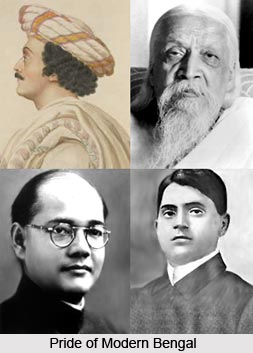 Modern History of Bengal has witnessed several historical events which included Bengal Renaissance, the Independence movement and the partition of Bengal. Bengal had witnessed major changes in all spheres due to the British rule in spheres of administration, education and army and so on. The trade and commerce was highly developed. Kolkata was made the commercial centre. It became the industrial hub. Under Warren Hastings British rule was consolidated. There were major changes in the zamindari system. In 1793 he declared their rights eternal and made over the land of Bengal to the previous zamindars, on condition that land tax would be fixed. This legislation is known as the Permanent Settlement of the Land Revenue. Again in the early 19th century compulsory schemes were introduced for the cultivation of Opium and Indigo. Peasants were forced to grow these crops which were purchased at below market rates for export.
Modern History of Bengal has witnessed several historical events which included Bengal Renaissance, the Independence movement and the partition of Bengal. Bengal had witnessed major changes in all spheres due to the British rule in spheres of administration, education and army and so on. The trade and commerce was highly developed. Kolkata was made the commercial centre. It became the industrial hub. Under Warren Hastings British rule was consolidated. There were major changes in the zamindari system. In 1793 he declared their rights eternal and made over the land of Bengal to the previous zamindars, on condition that land tax would be fixed. This legislation is known as the Permanent Settlement of the Land Revenue. Again in the early 19th century compulsory schemes were introduced for the cultivation of Opium and Indigo. Peasants were forced to grow these crops which were purchased at below market rates for export.
The Bengal Renaissance was a social reform movement which took place during the nineteenth and early 20th centuries in undivided Bengal during the period of British rule. It started with Raja Ram Mohan Roy and ended with Rabindranath Tagore. Bengal in the nineteenth century was a unique blend of religious and social reformers, scholars, literary giants, journalists, patriotic orators and scientists. All these elements merged to form the image of a renaissance thereby marking the transition from the medieval to the modern.
In the Indian independence movement Bengal played a major role. Major leaders in the freedom movement were Chittaranjan Das, Surendranath Banerjea, Netaji Subhash Chandra Bose, Bagha Jatin, Khudiram Bose, Surya Sen, Binoy-Badal-Dinesh, Sarojini Naidu, Aurobindo Ghosh, Rashbehari Bose and several others. Several people of Bengal laid their lives in the freedom struggle and many were exiled in Cellular Jail of Andaman.
In the 20th century modern Bengal became a witness to a major historical incident. This was the partition of the state. The first partition occurred in 1905 and the second partition in 1947. Bengal was split into the state of West Bengal of secular India and a Muslim region of East Bengal under Pakistan. It was renamed East Pakistan in 1958. East Pakistan rebelled against Pakistani military rule. They became independent republic of Bangladesh after a war of independence against the Pakistani army in the year 1971.



















